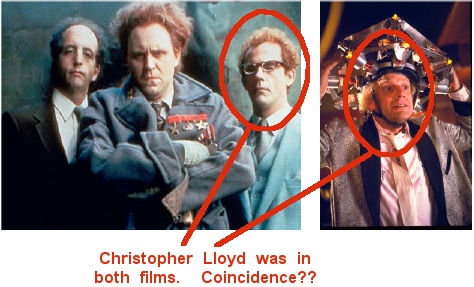If you were a young-ish science student in the mid-1980s there are two movies that remain in your collection to this day; Back To The Future and, of course, Buckaroo Banzai: Across The Eighth Dimension.
'Buckaroo Banzai' was completely inplausible - even I can't be a rock star, neurosurgeon and world class physicist. Well, maybe I can, but you can't and even I don't have my own video game and comic book like he does.
So for actual science discussions, Back To The Future remains the default movie of the period. Like Yahoo Serious in "Young Einstein", Marty ends up doing some science (in Marty's case by accident) but also invents rock and roll. Rock and roll shows up a lot in science movies. This is because music is math and math was created to give scientists something to do while sleeping.

The pesky part about the time machine in "Back To The Future" was powering the thing. It required '1.21 jigowatts' (Giga, Jiga? No one knows. Doc says it with a soft 'g' sound, which is the old timey pronunciation of Giga- but, as we'll see, it ain't all that much) to make the flux capacitor do its thing and that energy was provided by plutonium stolen from Libyan terrorists - of course, that could never happen today because back then you could say middle easterners were terrorists owing to the fact that they are) but that tells you part of the problem;
I just used the terms 'power the thing' and 'energy' interchangeably in my last paragraph and that's a common mistake, even for people like me who know what they are talking about. Watts, as in the 1.21 Jigowattevers needed to make the flux capacitor do its thing, aren't energy, they're power. Energy is instead power multiplied by time.
So when Marty's plutonium supply runs low they fall back on a lightning bolt ... but are they trying to get a ginormous burst of energy or power or what?
And how much is 1.21 Gigawatts (let's assume they mean a billion and not a made up term like 'ginormous') really? According to Wikipedia (I know, I know, but what do you want me to do, get out my VNA and measure lightning bolts?) a lightning bolt has 1.5×10^9 Joules. To put that in perspective, a Mars (love ya Mars! Send me some funding too) candy bar only has 1×10^6 J, so it's a lot more than a candy bar but is it enough to send me careening backward in time so I can date Lea Thompson? I think not.

Most appliances have both a power and voltage rating to help you figure it out. Your light bulb may say 100 watts but the socket (in America) is 120 volts also. Give it less than 100 watts and the light is dimmer.
Where am I going with this? Well, if 1.21 'jigowatts' is actually 1.21 gigawatts, it's a lot of watts - 1.2 billion - but nothing too outrageous, even in 1955. Watts are volts multiplied by amperes. A lightning bolt is 30,000,000 volts at 100,000 Amperes(1) so 300 Gigawatts, even taking out the radiated heat, is well over what was needed for the flux capacitor - provided that it was only needed for a fraction of a second.
It seems like an awfully complicated mess just to go back and invent rock and roll but luckily at the end of the movie they solve the power/energy issue by having Doc go forward in time and come back with a "Mr. Fusion" attached to his car. Because fusion veers into make-believe pretend energy we don't need to think about actual numbers now. One banana peel produces enough make-believe hydrogen energy to send the car into the future (the beer can was just for show, though I liked how he poured the beer in first, then threw in the can) and in that future wonder land we'll all enjoy a prosperous energy-wealthy existence - so that means to some we don't need to care about the environment at all now.
We're not quite at the Mr. Fusion stage yet but we can at least use the leftover food to create energy in other ways, namely in anaerobic digesters.
Greenfinch, a UK engineering firm, has gotten a $40 million contract from the British government to reduce the 16-18 million tons of food that is buried as landfill in Ludlow, Shropshire each year.
Why tackle it now? Not because of land issues - the "we're running out of space to store garbage" environmental hoax was tripped up a decade ago, but rather because of the "all that rotting food causes global warming" hysteria in vogue now.
Anaerobic digesters are not new. Like they sound, they basically work like a stomach. Stomachs are millions of years old, maybe longer. These non-stomach anaerobic digesters turn food into fertilizer and biogas (methane and carbon dioxide) which can be burned for electricity. The fertilizer can be spread around by politicians.
The concept has been around for decades but the methane impact on global warming (which, if you are not educated by politics, you know is 23X that of the carbon dioxide two countries in Europe could easily reduce thanks to nuclear power and closing Soviet-era East German factories and therefore disregarded as being part of the global warming problem) made it worth funding again.
Turn my leftover food into electricity and fertilizer to grow more food???
That sounds pretty darn efficient to me - at least until that Mr. Fusion comes along. Of course, we could all waste less food instead and not need $40 million anaerobic digesters (and that's just for one test site) but that's just crazy talk.
NOTES:
(1) Zim, Burnett, & Paul E. Lehr. Weather. New York: Golden Books, 1987: 99.




Comments